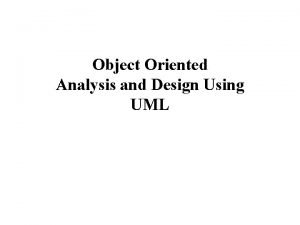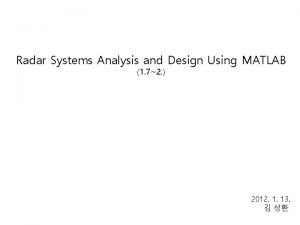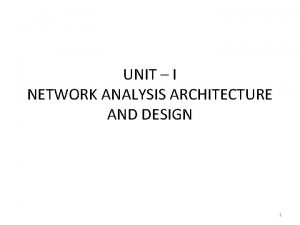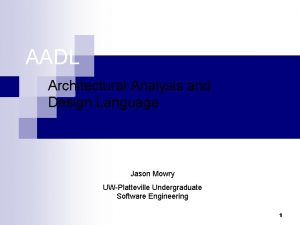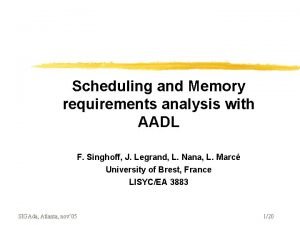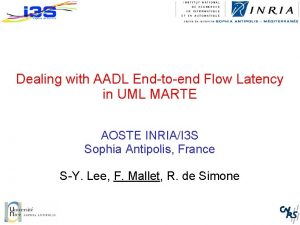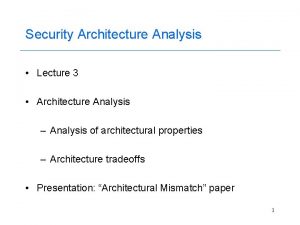Using Architecture and Analysis Design Language AADL to









- Slides: 9

Using Architecture and Analysis Design Language (AADL) to Independently Validate and Verify (IV&V) System Performance Requirements and Design Performance With System Models Tom Hempler, NGC Nikki Johnson, NGC Steve Raque, NASA IV&V Executive Presentation September, 2008 MAC-N IV&V Research

Collaboration Team And Stakeholders • Lisa Montgomery – NASA IV&V Research Lead • Steve Raque – NASA POC for AADL Research Infusion, SRM/ Validation Product Line Lead • Frank Huy – NASA IV&V Verification Product Line Lead • Ken Mc. Gill – NASA POC for the system being modeled • Tom Hempler – Principal Investigator • Nikki Johnson – Senior Systems Analyst 2

Agenda • Problem Statement and Research Objectives • Modeling Language Overview • AADL / SRM Integration Approaches Investigated • Common Techniques for AADL Infusion • Performance Validation & Verification • Summary 3

Problem Statement and Research Objectives • Problem Statement – Performance requirements, design and implementation validation and verification when tasked by NASA programs, is currently accomplished manually on a limited basis. • Objectives – Provide an overview of AADL infusion techniques examined during the investigation – Report on AADL technology infusion alternatives for performance analysis of the system reference model – Characterize the UML Extension for AADL and its applicability to validating and verifying performance of the modeled system 4

Modeling Language Overview • Modeling History – AADL and UML standards were established to model systems – Government researched a variety of modeling methods for systems • Do. D researched UML to model functionality • NASA researched AADL to model performance and UML to model behavior – JPL researched AADL and applied its processes to flight projects • Model Language Comparison – Both languages support threads and system/software architecture – Unlike UML, AADL fills the performance analysis gap when modeling systems; and it extends the IV&V capability with dynamic analysis – Like UML, AADL is used to model the structure and operations of the system 5

AADL / SRM Integration Approaches Investigated • Utilize XMI to transfer artifacts between OSATE and Together – Export AADL model using XML files created in the OSATE environment – Import AADL model into the UML model using Together’s XMI feature • Utilize Java files to transfer artifacts between OSATE and Together – Generate Java code for AADL model and import it into Together – Create AADL domain model from Java files within the Together UML model • Utilize the AADL profile to build an AADL model in Together – Create the AADL performance model as part of the UML system model – Attribute the UML domain with AADL performance parameters • Manual Transfers between OSATE and Together – Create AADL model and UML model independently – Analyze system performance within OSATE and manually attribute the UML domain model with AADL performance attributes 6

Common Techniques for AADL Infusion • Use MARTE profile with embedded AADL support or an AADL profile to construct a UML model with performance constraints – Construct architecture as a common domain for both AADL and UML models – Extract assertions from AADL flows and test using SRM bridges – Use validated assertions to test AADL feature attributed architecture, validate performance requirements, and verify as-designed performance • Use OSATE/AADL to construct a performance loaded architecture – Construct architecture with components, data flows, and threads – Attribute architecture with performance requirements during validation and as-designed performance during verification – Analyze system performance while adjusting performance parameters – Flow optimum performance attributes into SRM domain via XMI for assertion testing 7

Performance Validation & Verification • Model system architecture and assign performance attributes in UML and AADL to establish migration points • Characterize critical performance parameters vital to a system’s correct operation such as: – – – • Validate real-time architecture concerns and critical performance constraints using SPT (Schedulability, Performance and Timing) analysis within the AADL model – 8 Sensor/command data latency and update rates CPU utilization Synchronous/asynchronous task management Data-bus packet definitions and update rates End-to-end latency, jitter, execution flow Validate performance requirements within the UML model using validated SPT from AADL • Designed and implemented performance is verified through the OSATE tests for latency, processing time, and schedulability tests conducted on the AADL model • Performance requirements are verified and validated through the use of assertion test suites, J-Unit tests and performance analysis using AADL in concert with UML

Summary • Manually transferring performance data from the AADL model to the UML model is a viable approach to performance IV&V • Continue performance analysis using AADL plug-in tools • Future Work – Extend model based IV&V by using AADL profiles for UML – Extract assertions from AADL flows and test using SRM bridges – Use validated assertions to test performance attributed architecture, validate performance requirements, and verify as-designed performance 9 Internet Site – http: //www. aadl. info
 Aadl 1
Aadl 1 Architecture analysis and design language
Architecture analysis and design language Radar systems analysis and design using matlab
Radar systems analysis and design using matlab Object-oriented systems analysis and design using uml
Object-oriented systems analysis and design using uml Object oriented analysis and design using uml
Object oriented analysis and design using uml Radar systems analysis and design using matlab
Radar systems analysis and design using matlab Network analysis architecture and design
Network analysis architecture and design Basic principle of input design
Basic principle of input design User interface design in system analysis and design
User interface design in system analysis and design Dialogue design in system analysis and design
Dialogue design in system analysis and design




